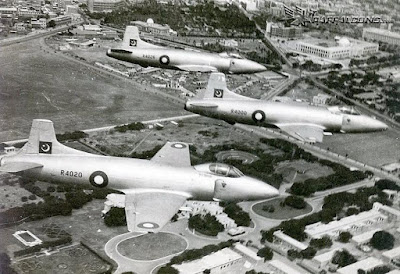Handling problems with the Spiteful prototype delayed progress on the jet-powered version, leading to the pre-production order of 24 being stopped, although work on the three prototypes continued. The Fleet Air Arm instead bought 18 de Havilland Vampire Mk. 20s to gain experience with jet aircraft. The RAF rejected both designs since they offered no perceptible performance advantage over the contemporary Gloster Meteor and the de Havilland Vampire, the RAF's first two operational jet aircraft. Supermarine offered a navalised version of the project to the Admiralty. The prototype Type 392 serial number TS409 land version was first flown on 27 July 1946, by test pilot Jeffrey Quill.
The first navalised prototype, Type 398 TS413 flew on 17 June 1947 flown by test pilot Mike Lithgow, three years after the Meteor had made its first flight. Production orders for the FAA were placed in November 1949. The first production aircraft to take to the skies was the F.1 variant in 1950, entering service with the FAA in August 1951 with the first squadron being 800 Naval Air Squadron. The F.1's armament consisted of four 20 mm (.79 in) Hispano Mk. V cannons, with 125 rounds of ammunition per gun. It was powered by a single Rolls-Royce Nene Mk. 101 turbojet engine.
The Attacker had a brief career with the Fleet Air Arm, not seeing any action during its time with the FAA and being taken out of first-line service in 1954. It remained in service with the Royal Naval Volunteer Reserve (RNVR) for a little while longer, being taken out of service in early 1957. The Attacker was replaced in the front line squadrons by the later and more capable Hawker Sea Hawk and de Havilland Sea Venom.
In the early 1950s, when the newly formed Royal Pakistan Air Force (RPAF; later Pakistan Air Force) sought to acquire jet fighters, a lack of funds, combined with pressure from British suppliers persuaded it to acquire the Supermarine Attacker “P” (Type 538), a “de-navalised” variant of the type used by the FAA.
The only squadron to be equipped with these aircraft, from 1953, was an interceptor unit, No. 11 “Arrows” Squadron. A total of 36 Attackers had been acquired when “Arrows” Squadron officially converted to the F-86F Sabre, on 18 January 1956. However, some sources state that Attackers were used by PAF until 1960.
In the RPAF the Attacker was regarded as unsatisfactory, due to frequent maintenance problems and a relatively high attrition rate.
Two more variants of the Supermarine Attacker were built for the FAA. The FB 1 was a fighter-bomber which differed little from the F 1 except that it was expected to operate as a ground attack aircraft. The third, and last, variant of the Attacker was the FB 2 which introduced a new Rolls-Royce Nene engine and modifications to its structure. The Supermarine Attacker now had eight underwing pylons which could carry two 1,000 lb (454 kg) bombs or eight unguided rockets.
Land based Nene 4 powered variant for the Pakistan Air Force, 36 built with the first delivered in 1953.
On 23 May 1950, Vickers test pilot Les Colquhoun was flying the first production Attacker F.1 WA469; he carrying out high speed tests when during one of the tests the outer portion of the starboard wing folded up and the ailerons became locked. Colquhoun decided not to eject and managed to do a high-speed landing at Chilbolton, in the course of which he used all but the last 100 yards (90m) of the runway and burst a tyre. He had saved the aircraft so the cause of the incident could be discovered and was awarded the George Medal for his efforts.
On 5 February 1953, Attacker FB.1 WA535 from RNAS Stretton crashed near Winwick, Cheshire, killing the pilot.
An accident on 10 November 1955, in Attacker FB.2 WP281, claimed the life of the chief Flying Instructor, Lieutenant Commander Charles James Lavender DSC (see RNAS Stretton).
Following its retirement from service in 1956, Attacker F.1 Serial number WA473 was placed on display on the gate at RNAS Abbotsinch. Completed at VAs South Marston factory in July 1951, it had served with 702 and 736 Naval Squadrons. In late 1961 it was moved to the Fleet Air Arm Museum in Somerset, UK.
General characteristics
Crew: 1
Length: 11.43 m
Wingspan: 11.25 m
Height: 3.02 m
Wing area: 21.0 m2
Empty weight: 3,826 kg
Gross weight: 5,539 kg
Powerplant: 1 × Rolls-Royce Nene turbojet, 22 kN thrust
Maximum speed: 950 km/h
Range: 950 km
Service ceiling: 13,716 m
Rate of climb: 32.3 m/s
Guns: 4 × Hispano No. 3 Mark 5 20mm Cannon









good !
VastaaPoistaThanks !
Poista